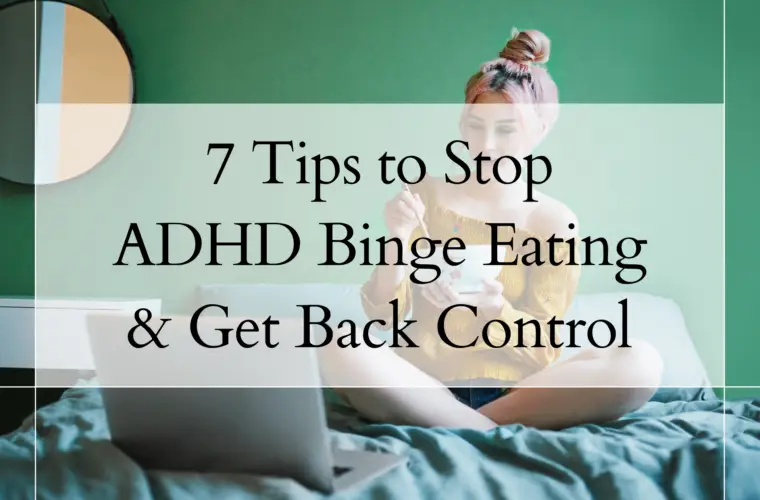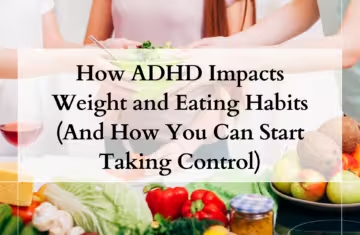Have you ever found yourself so absorbed in a task that you lose track of time and forget to eat?
Or, the thought of thinking of something to eat and then preparing it feels so overwhelming, you just skip it all together? Only to later find yourself ravenous, shaky and eating everything in sight?
Welcome to ADHD Binge eating!
Around 30% of adults with binge eating disorder also have a history of ADHD according to research. This is thought to be because adults with binge eating disorder are more sensitive to food related rewards than most people.
So yes, your ADHD could be a major factor in your binge eating. And, your overall eating habits.
In this article I’ve put together 9 tips on how to stop binge eating with ADHD.
How to Stop Binge Eating When You Have ADHD
Learn to Manage Your ADHD First.
This may seem kind of obvious, but ADHD itself can cause the executive dysfunction, hyper-focus, feelings of overwhelm and time blindness that all contribute to binge eating. So it makes sense to first start managing the ADHD itself.
This can be through medication, specialist ADHD coaching or taking a holistic approach through exercise and nutrition. Ideally a combination of these things.
Exercise (don’t hate me!)
Now, stay with me here. Regular exercise is the most effective habit you can build to improve your ADHD symptoms.
Now, I appreciate that maintaining an exercise routine is hard enough for most people. Add ADHD in the mix and you may as well be asking yourself to kayak to Australia!
The key to sticking to a regular exercise routine is to do something you enjoy. Or, at the very least, something that keeps your brain engaged.
Do you find you start an exercise routine and then get bored after a week or two? Or even during the workout?
I get it! Running or cycling at the gym IS seriously boring! No wonder people quit!
Instead find ways to exercise that engage your brain. Pilates or Pilates inspired classes like the Tracy Anderson Method and the B Method are great because they challenge your brain and keep you engaged. Dance classes like Zumba, trampoline exercise videos like BOUNCE are also ADHD friendly because they make exercising feel more fun. Also, the fast pace of the classes helps you pay more attention.
You don’t have to workout in a gym either. In fact, with the internet and streaming it’s never been so easy to workout at home. This cuts down on all those extra steps you have to take. Making it more likely you will follow through.
If exercise feels overwhelming. Start off with just ten minutes, 3 times a week. Once you are comfortable with that, work on building up to 150-300 minutes of exercise a week.
Plan Regular Meals (don’t worry there are ADHD friendly ways)
I know, I know! It’s easier said than done, right?
But blood sugar crashes caused by skipping meals are what can lead to binge eating. Especially later at night, which then goes on to affect your quality of sleep. Which in turn affects your weight, adhd symptoms…
And your ADHD symptoms cause the skipping meals and binge eating.
Do you see how it becomes like a falling row of dominoes?
To avoid this aim to eat every 4-5 hours throughout the day.
Try to have a large breakfast, medium sized lunch and a light meal in the evening. The complete opposite of the norm I know!
But, by eating your larger meal at the start of the day you are fuelling yourself up for the day ahead. Instead of eating your largest meal at the end of the day when you are winding down. This makes much better use of resources and helps you manage your weight more efficiently.
To remember to eat regularly, set reminders for yourself to eat. You can even leave post notes around to remind yourself to eat regularly and remind you how you’ll feel later if you don’t eat now.
When it comes to prepping meals, choose the path of least resistance.
Make your meals as simple, quick and easy as possible. Meal prepping for the week is one way to go and is often suggested. But, if you are like me and the idea of giving up half your Sunday to cook meals for a whole week sounds like torture, then try using quick 10 minute recipes.
Let’s break this down…
When you have ADHD the biggest problem of meal planning, prepping and grocery shopping is all that executive function required to get food on the table.
It’s exhausting!
So keep it simple. Have a list of quick and easy recipes, screenshot the ingredients list and put them in an album on your phone. That way you don’t have to keep finding the recipes you want, writing a list and all that work every week. When you find yourself in a supermarket wondering what to eat and drawing a blank you can get your phone out and have your ingredients lists there.
Use shortcuts in your cooking like using microwaveable rice instead of rice you cook yourself, use an air fryer, buy pre chopped veg, salad kits, stir fry kits. Make it simple so your brain can’t argue with you (I have a curated collection of recipes over on my Pinterest which are all ADHD friendly)
Another alternative is to use meal delivery boxes like Mindful Chef.
Balance Your Meals.
By eating balanced meals you will stay full for longer, reduce cravings for sugar and carbs.
Aim to balance your plate with ⅓ carbs, ⅓ protein and ⅓ veggies.
For example, cook some chicken or tofu, cook some gnocchi and add a salad kit. It’s a low effort, and ADHD friendly meal done in 20 minutes with next to no prep.
This will all help you control your ADHD binge eating.
Eat (some) Sugar (no I’m not kidding!)
Let me explain…
When you go to extremes and try to cut out all sugar, it leaves you pretty miserable and craving sugar even more. Those sugar craving can have even more intensity for people with ADHD. Because the ADHD, dopamine seeking brain craves the dopamine hit it gets from sugar and carbs.
Instead of going cold turkey, reduce your intake gradually. Make sure to allow yourself a designated treat night in the week. You can even do a planned binge if you find your ADHD binge eating sessions are regular occurrences.
This may sound counter productive but you will end up eating less sugar than before. And, the less sugar you eat, the less cravings you will experience and the less binge eating struggles you will have.
Take up Journaling.
Starting a journaling practice can make you more aware of your emotions. This means you can start identifying any connections between what you feel and when you binge eat.
You may find boredom, upset, overwhelm or stress are triggers for you to binge eat.
How does this change things?
Well, once you can identify your triggers you can come up with healthier ways to deal with your emotions instead of binge eating.
Work with a Health Coach.
A health coach that specialises in ADHD can be especially useful for people who struggle with ADHD binge eating, are overweight and/or struggle with meal planning and grocery shopping.
A good health coach can give you strategies to help you manage your binge eating. They can also help you put in healthy routines that you will actually follow through on, create a consistent exercise schedule and help you understand how your ADHD is affecting your health.
As a certified Holistic Health Coach, and a fellow ADHDer, I understand the struggles you have and the frustration of searching for answers in a world that isn’t set up for our ADHD brains.
I know what it’s like to try so hard only to have your brain betray you.
That’s why I created The Mind & Body Transformation Programme specifically for women with ADHD. I offer 12 weeks of 1:1 health coaching for women who feel trapped, and struggle with binge eating, overeating and emotional eating.
Navigating life with ADHD isn’t easy. We all need that extra help sometimes to get us un stuck.
Overall, by understanding the link between ADHD and binge eating you can have a better understanding of yourself.
And most importantly, you can stop blaming yourself!




